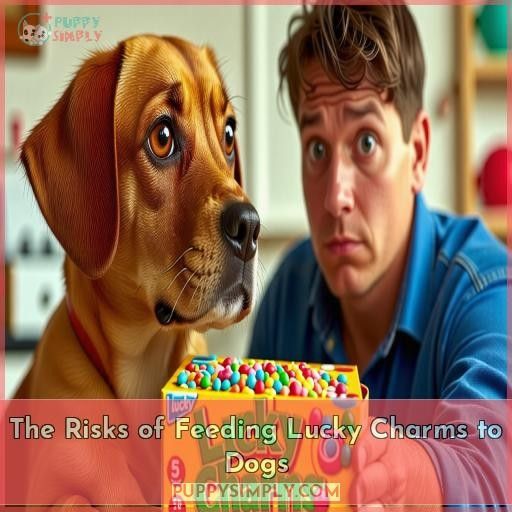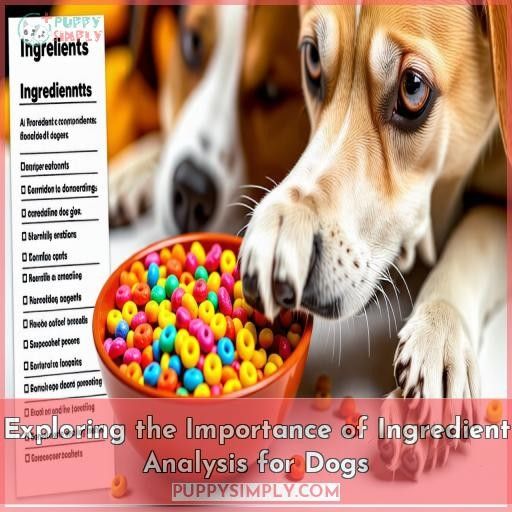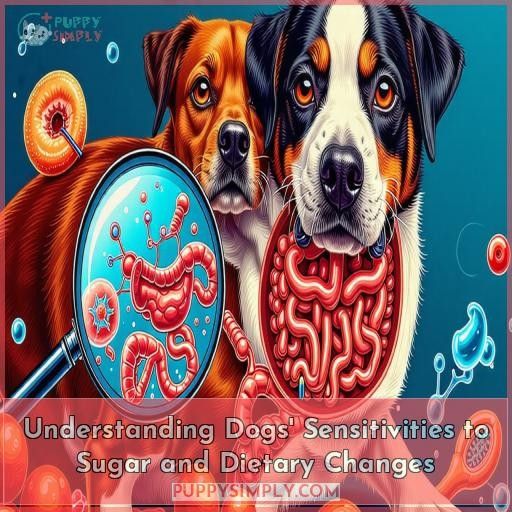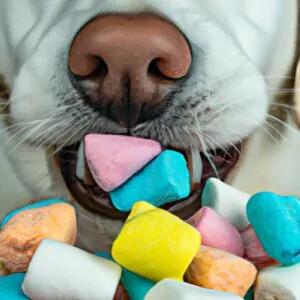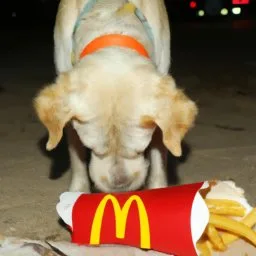This site is supported by our readers. We may earn a commission, at no cost to you, if you purchase through links.
 You should avoid feeding your dog Lucky Charms. This sugary cereal contains ingredients that can harm your furry friend. The high sugar and salt content can lead to obesity, diabetes, and gastrointestinal issues.
You should avoid feeding your dog Lucky Charms. This sugary cereal contains ingredients that can harm your furry friend. The high sugar and salt content can lead to obesity, diabetes, and gastrointestinal issues.
Some ingredients like chocolate, xylitol, and raisins are potentially toxic to dogs, causing vomiting, seizures, or even kidney failure. While those colorful marshmallows may seem tempting, they provide no nutritional value.
Instead, offer your pup healthy treats like carrots, berries, or xylitol-free peanut butter. Their tail will be wagging for more once you learn the safer, delicious options.
Table Of Contents
- Key Takeaways
- Can Dogs Eat Lucky Charms?
- Can Dogs Consume Lucky Charms?
- The Risks of Feeding Lucky Charms to Dogs
- Are Marshmallows Safe for Dogs?
- Understanding the Risks of High Sugar Intake for Dogs
- Providing Safer Alternatives for Dogs
- What to Do if Your Dog Ingests Lucky Charms
- Exploring the Importance of Ingredient Analysis for Dogs
- Understanding Dogs’ Sensitivities to Sugar and Dietary Changes
- Monitoring and Managing Dogs’ Sugar Intake
- Promoting a Safe Diet for Dogs
- Frequently Asked Questions (FAQs)
- Are dogs allowed Lucky Charms?
- Are Lucky Charms safe to eat?
- Can my dog eat fruity pebbles?
- Can dogs eat froot loops cereal?
- How much Lucky Charms is too much for dogs?
- Can dogs have Lucky Charms as a regular treat?
- What are the long-term effects of feeding Lucky Charms?
- How can I transition my dog off Lucky Charms safely?
- Are there any health benefits to feeding Lucky Charms?
- Conclusion
Key Takeaways
- Lucky Charms are not safe for dogs due to their high sugar, salt, and potentially toxic ingredients like chocolate, xylitol, and raisins.
- The high sugar content in Lucky Charms can lead to obesity, diabetes, gastrointestinal distress, and hyperactivity in dogs.
- Marshmallows, a component of Lucky Charms, can pose risks for dogs due to their high sugar content and potential inclusion of xylitol.
- It’s crucial to provide dogs with safer alternatives to Lucky Charms, such as healthy fruits, vegetables, and xylitol-free peanut butter, to ensure their well-being.
Can Dogs Eat Lucky Charms?
No, dogs shouldn’t eat Lucky Charms. Lucky Charms is a sugary breakfast cereal that contains ingredients like sugar, salt, and artificial colors that can be harmful to dogs if consumed in large amounts.
Dogs have a much lower tolerance for sugar and processed foods compared to humans, so it’s best to avoid feeding them Lucky Charms or any other sugary human snacks.
Can Dogs Consume Lucky Charms?
When considering the health of dogs, concerns arise regarding serving size and treats like Lucky Charms. These sugary cereals can be toxic to dogs due to ingredients like chocolate or potential xylitol. Understanding the risks is essential before offering such treats, ensuring your furry friend stays safe and healthy.
Training yourself to identify harmful elements in popular foods like Lucky Charms is vital for your dog’s well-being and overall health. Be mindful of what you share with your four-legged companion to prevent any unwanted consequences.
The Risks of Feeding Lucky Charms to Dogs
The high sugar and salt content in Lucky Charms makes it an unhealthy treat for dogs that can potentially lead to issues like obesity, diabetes, and gastrointestinal distress. Additionally, the cereal contains artificial food dyes like Yellow 5 and Yellow 6, which may trigger allergic reactions or hyperactivity in some dogs.
Sugar and Salt Content
When considering feeding Lucky Charms to dogs, be cautious of the high sugar and salt content present in this cereal. These empty calories can lead to weight management issues and long-term health concerns for your pet. Watch out for hidden sugars that may exceed recommended daily limits for dogs. Moderation is key when offering cereals as treats, ensuring they don’t become a staple in your dog’s diet. Opt for cereals with lower sugar and salt content to promote your dog’s overall well-being.
- Be mindful of the high sugar and salt content in Lucky Charms.
- Empty calories in cereals can impact weight management.
- Hidden sugars may exceed daily limits for dogs.
- Treat cereals as occasional treats, not a dietary staple.
- Choose cereals with lower sugar and salt levels for better health.
Potential Dangerous Ingredients
In addition to the high sugar and salt content, Lucky Charms also contains several ingredients that can be dangerous for dogs. Chocolate, found in some Lucky Charms varieties, is toxic to canines and can cause vomiting, diarrhea, tremors, and even seizures. Artificial dyes like Red 40 may trigger allergic reactions and hyperactivity. The artificial sweetener xylitol is particularly concerning, as it can lead to dangerously low blood sugar and liver damage. Raisins, another common cereal ingredient, can cause kidney failure in dogs. Even the preservative BHT poses long-term health risks. Steer clear of these hazardous components and opt for dog-safe treats instead.
| Ingredient | Potential Harm | Symptoms |
|---|---|---|
| Chocolate | Toxicity | Vomiting, diarrhea, tremors, seizures |
| Artificial Dyes | Allergic Reactions, Hyperactivity | Skin irritation, behavioral changes |
| Xylitol | Hypoglycemia, Liver Damage | Low blood sugar, lethargy, seizures |
| Raisins | Kidney Failure | Vomiting, lethargy, increased thirst |
| BHT | Long-Term Health Risks | Unknown long-term effects |
Are Marshmallows Safe for Dogs?
While marshmallows may seem like a harmless treat, they can actually pose some risks for your canine companion. The high sugar content in marshmallows can lead to gastrointestinal upset, and some varieties even contain xylitol – a sweetener that’s highly toxic to dogs.
To be on the safe side, it’s best to avoid feeding marshmallows to your pup altogether. Instead, consider offering healthier training treats like small pieces of fruit or low-calorie, dog-safe snacks.
With a little creativity, you can satisfy your dog’s sweet tooth without the potential dangers.
Understanding the Risks of High Sugar Intake for Dogs
The risks of high sugar intake for dogs are serious. Excess sugar can lead to obesity, increasing the chances of diabetes, dental problems, and even pancreatitis. Sugary cereals like Lucky Charms can also cause hyperactivity in some dogs.
While an occasional small treat may be fine, regularly feeding your dog sugary human foods like this cereal isn’t recommended. Instead, stick to dog-safe, low-sugar options that won’t jeopardize your pup’s health.
Your dog’s wellbeing should always come first when considering their diet.
Providing Safer Alternatives for Dogs
While Lucky Charms may seem like a fun treat, it’s best to steer clear and provide your pup with healthier alternatives. Why not try whipping up some homemade dog treats using wholesome ingredients like:
- Carrots or sweet potatoes for a crunchy, vitamin-packed snack
- Frozen banana slices for a cool, creamy delight
- Unsweetened applesauce or plain yogurt for a delicious, protein-rich option
- Peanut butter (xylitol-free) baked into biscuits or st■ into a Kong
- Fresh berries like blueberries or strawberries for a naturally sweet treatT
hese safer, balanced options will satisfy your dog’s cravings without the risks of sugary cereals.
What to Do if Your Dog Ingests Lucky Charms
If your dog ingests Lucky Charms cereal, it’s crucial to monitor for potential effects like vomiting, diarrhea, or lethargy caused by the high sugar content. Consult your veterinarian if symptoms persist or worsen, as they can guide dietary management, recommend supportive treatments, and determine if further intervention is necessary.
Potential Effects & Monitoring Guidelines
If your dog ingested Lucky Charms, monitor for behavioral changes, symptom duration, and hydration status. Additionally, observe activity levels and keep track of the recovery timeline to guarantee their well-being. Seek veterinary attention if symptoms worsen or persist.
Dietary Management After Ingestion
After a 24-hour fast, gradually reintroduce a bland, easily digestible diet like boiled chicken and rice. Monitor your dog closely for any signs of continued gastrointestinal upset, and consult your veterinarian if symptoms persist or worsen.
Supportive Treatments in Case of Ingestion
If your dog ingests Lucky Charms, consult your vet about using Pepcid (0.25mg/lb every 12 hours) to ease nausea. Probiotics like FortiFlora or plain yogurt can help restore gut balance. Offer a bland diet of chicken and rice until symptoms subside.
| Pepcid Dosage | Probiotic Options | Yogurt Benefits |
|---|---|---|
| 0.25mg/lb every 12 hours | FortiFlora | Restores gut balance |
Knowing When to Seek Veterinary Attention
If your dog exhibits severe vomiting, diarrhea, or lethargy after eating Lucky Charms, seek veterinary attention immediately. Watch for:
- Worsening symptoms
- Persistent issues
- Dehydration
- Unusual behavior changesP
rompt professional care can prevent complications and guarantee your dog’s full recovery.
Exploring the Importance of Ingredient Analysis for Dogs
In the domain of feeding your canine companion, ingredient analysis is of utmost importance. Carefully examine the labels of any cereal or treat, as even seemingly harmless options like Lucky Charms may contain hidden dangers.
Stay informed about recalls and keep abreast of ingredient research to make well-informed decisions. Compare the nutritional profiles of different options, and be mindful of your dog’s unique dietary needs and potential food allergies.
With diligence and a commitment to your pup’s wellbeing, you can confidently navigate the landscape of canine nutrition.
Understanding Dogs’ Sensitivities to Sugar and Dietary Changes
As a dog owner, it’s important to understand that your canine companion’s sensitivity to sugar and dietary changes can vary greatly depending on their breed, age, and overall health.
Some dogs may have pre-existing conditions like diabetes or pancreatitis that require extra caution regarding sugary treats like Lucky Charms.
Pay close attention to how your dog’s body reacts to any new foods, and be prepared to adjust their diet accordingly.
With a little care and monitoring, you can make certain your pup stays happy and healthy.
Monitoring and Managing Dogs’ Sugar Intake
Monitoring your dog’s sugar intake is essential to their health. Be mindful of hidden sugars in treats and table scraps.
Stick to the daily limit of under 10 grams of sugar for a 40-pound dog. Opt for healthy, low-sugar treats like carrots, green beans, or dog-safe fruits in moderation. Avoid sugary cereals like Lucky Charms.
High sugar intake can lead to weight gain, diabetes, and other long-term health issues. Keep an eye on your pup’s blood sugar levels and overall well-being. A little diligence goes a long way in keeping your furry friend happy and healthy.
Promoting a Safe Diet for Dogs
Now that you understand the risks of feeding sugary cereals like Lucky Charms to your canine companion, it’s time to focus on promoting a safe, balanced diet. To keep your dog healthy and happy, consider these tips:
- Prioritize fresh, whole-food ingredients over highly processed kibble.
- Portion control treats, ensuring they make up no more than 10% of your dog’s daily calories.
- Offer healthy, low-sugar snacks like carrots, green beans, or apple slices.
- Consult your veterinarian to verify your dog’s dietary needs are met.
Frequently Asked Questions (FAQs)
Are dogs allowed Lucky Charms?
While the sugary exterior might seem enticing, you’re better off sparing your furry companion the upset tummy – Lucky Charms aren’t the wisest treat choice for our canine friends.
Are Lucky Charms safe to eat?
Lucky Charms cereal isn’t a wise choice for your furry friend. The high sugar content, artificial colors, and lack of nutritional value can potentially harm their health. As an occasional treat in tiny portions, it might be okay – but opt for safer, more balanced dog treats instead.
Can my dog eat fruity pebbles?
While fruity pebbles aren’t toxic, they’re high in sugar and lack nutritional value for dogs. You shouldn’t make fruity pebbles a regular treat – stick to healthier options.
Can dogs eat froot loops cereal?
Imagine finding your pup gobbling down Froot Loops! While not toxic, they’re packed with sugar and lack nutrients dogs need. As an occasional treat in moderation, these colorful loops might brighten your pup’s day – but prioritize a balanced, nutritious diet first.
How much Lucky Charms is too much for dogs?
Avoid giving your dog more than a couple marshmallows from Lucky Charms. The high sugar content can cause digestive upset and diarrhea if consumed in excess.
Can dogs have Lucky Charms as a regular treat?
Throwing caution to the wind, Lucky Charms shouldn’t be a regular dog treat. These sugary cereals are a recipe for weight gain and health issues like diabetes if given too often – just an occasional nibble at most.
What are the long-term effects of feeding Lucky Charms?
You shouldn’t regularly feed Lucky Charms to dogs. The high sugar and salt content can contribute to obesity, diabetes, and other health issues over time.
How can I transition my dog off Lucky Charms safely?
Steer your pup away from the sugary path like a ship avoiding rocky shores. Gradually swap Lucky Charms for nutrient-dense kibble, monitoring for digestive distress. With patience and care, your furry mate will begin a healthier journey.
Are there any health benefits to feeding Lucky Charms?
No, there are no real health benefits to feeding Lucky Charms to dogs. The cereal is high in sugar and provides little nutritional value, potentially leading to obesity, dental issues, and other problems.
Conclusion
Ultimately, indulging your canine companion with Lucky Charms is a risky affair. This sugary cereal can pose severe health risks due to its high sugar, salt, and potential toxic ingredients.
As a responsible pet owner, it’s imperative to prioritize your furry friend’s well-being by providing safe, nutritious treats. By exploring healthier alternatives and closely monitoring your dog’s diet, you can guarantee their tail keeps wagging with joy and good health.


